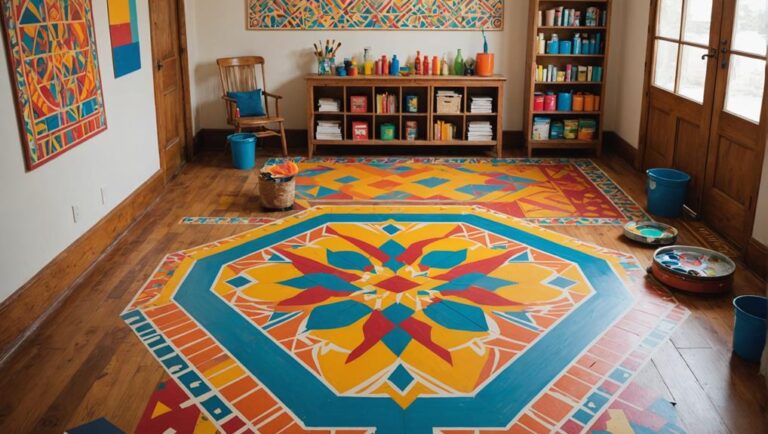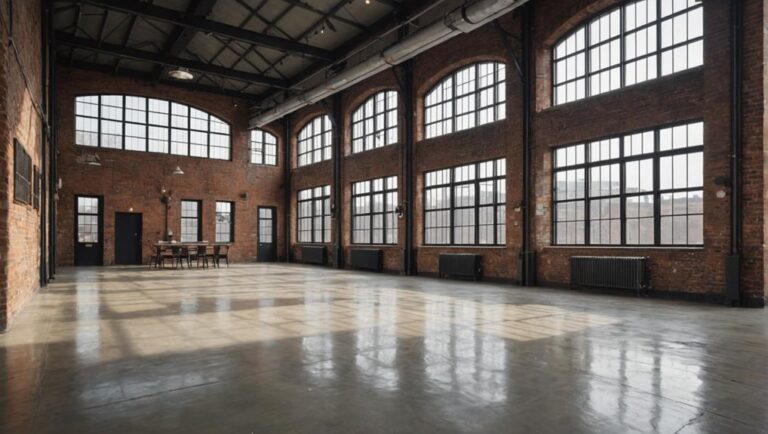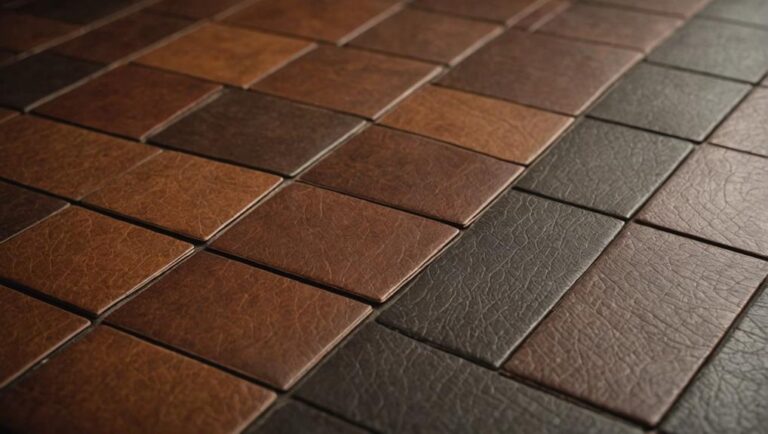For shared living spaces, choosing durable flooring is essential for maintaining a comfortable and functional environment. Consider options like luxury vinyl plank, which mimics wood and is water-resistant, or engineered hardwood, offering stability and low maintenance. Tile flooring provides excellent moisture resistance and design flexibility, while bamboo and cork are eco-friendly alternatives that bring sustainability. These materials help reduce allergens and are easy to clean. Prioritizing slip-resistant surfaces enhances safety, especially in high-traffic areas. To further understand which flooring best fits your needs, you might explore more detailed insights on available options and maintenance strategies.
Benefits of Durable Flooring
When evaluating flooring options, the benefits of durable flooring can't be overstated. Durable flooring not only enhances the aesthetic appeal of your space, but it also provides significant practical advantages. One key benefit is cost efficiency. While the initial investment may be higher than less durable alternatives, durable flooring materials often require less maintenance and replacement over time. This means you save money in the long run, making it an economically sound choice for shared living spaces.
Another important aspect to evaluate is noise reduction. In environments where multiple occupants share a living space, sound transmission can become a major concern. Durable flooring options, such as cork or rubber, are designed to absorb sound, minimizing noise between rooms and creating a more peaceful atmosphere. This feature is particularly beneficial in multi-story settings, where footsteps and other sounds can easily disturb neighbors.
Moreover, durable flooring can enhance safety. Many of these materials offer slip-resistant surfaces, which can help prevent accidents, particularly in high-traffic or wet areas. Choosing flooring that prioritizes safety not only protects residents but also contributes to a more comfortable living environment.
Best Flooring Options
When selecting flooring, you've got several durable options to evaluate. Luxury vinyl plank offers a water-resistant surface, while engineered hardwood provides the beauty of real wood with added stability. Additionally, tile flooring stands out for its exceptional durability, making it a practical choice for high-traffic areas.
Luxury Vinyl Plank
Luxury vinyl plank (LVP) flooring has rapidly become one of the top choices for homeowners and businesses alike, thanks to its impressive durability and aesthetic versatility. LVP mimics the look of hardwood, stone, or tile, offering a stylish finish while remaining highly practical for shared living spaces.
One of the key advantages of LVP is its resistance to moisture, making it ideal for areas prone to spills or humidity, like kitchens and bathrooms. When it comes to installation techniques, LVP offers various options, such as click-lock and glue-down methods, allowing for a straightforward installation process. This means you can achieve a professional-looking floor without extensive labor costs.
In addition to its practicality, LVP provides incredible design versatility. You can choose from an extensive range of colors, textures, and styles to suit your taste and décor. Plus, many LVP products come with a textured surface, enhancing slip resistance and safety, which is essential in shared living environments. Overall, LVP stands out as a durable, stylish, and safe flooring solution that meets the needs of modern living.
Engineered Hardwood Benefits
Although you might be drawn to solid hardwood for its timeless appeal, engineered hardwood offers a compelling alternative with numerous benefits. One of the key advantages is its stability. Engineered hardwood is constructed with multiple layers, making it less susceptible to warping and moisture damage, which is essential in shared living spaces.
When it comes to installation techniques, engineered hardwood is versatile. You can choose between floating, glue-down, or nail-down methods, allowing for easier installation over various subfloors. This adaptability can save you time and labor costs, making it a practical choice.
Cost considerations are also significant. Engineered hardwood generally comes at a lower price point than solid hardwood while providing a similar aesthetic. This affordability doesn't compromise quality; it offers the look of real wood without the high maintenance costs associated with solid options.
Additionally, engineered hardwood is often easier to maintain, requiring only regular sweeping and occasional mopping. This low-maintenance aspect is essential for shared spaces, where durability and safety are paramount. Overall, engineered hardwood is a smart investment for those prioritizing both style and functionality in their flooring choice.
Tile Flooring Durability
Tile flooring stands out as one of the most durable flooring options available today. Its resilience makes it an ideal choice for shared living spaces where foot traffic and spills are common. Tiles are resistant to scratches, dents, and moisture, ensuring a long-lasting surface that can withstand the rigors of daily use.
When it comes to tile maintenance, you'll find that keeping your floors looking pristine is relatively straightforward. Regular sweeping and mopping with mild cleaners will help maintain their appearance without compromising safety. Additionally, the grout lines should be sealed and cleaned periodically to prevent staining, enhancing the overall tile aesthetics of your space.
Another benefit of tile flooring is its ability to fit various design styles. With a wide range of colors, patterns, and textures, you can achieve the look you desire while enjoying the practical benefits of durability. In addition, tile doesn't harbor allergens, making it a safe choice for those sensitive to dust and other irritants. Overall, tile flooring is a reliable and stylish option that meets both durability and safety needs for shared living environments.
Hard Surface Flooring
When considering flooring options, hard surface flooring stands out for its durability and ease of maintenance. This type of flooring is ideal for shared living spaces, where safety and longevity are paramount. Hard surface materials, like vinyl, laminate, and hardwood, provide a robust foundation that can withstand the wear and tear of daily life.
Here are some key features of hard surface flooring:
- Durability: Resistant to scratches, stains, and moisture, making it suitable for high-traffic areas.
- Easy Maintenance: A simple sweep and occasional damp mop can keep your floors looking new.
- Variety of Styles: Comes in a wide range of colors and finishes, allowing you to match any design trends.
- Comfort: Many hard surface options can be installed over underlayment, providing additional cushioning and noise reduction.
- Safety Features: Many products are designed with slip-resistant surfaces, enhancing safety in homes with children and elderly residents.
When exploring installation techniques, you'll find that many hard surface options are designed for straightforward DIY projects or professional installation, ensuring you can achieve a perfect fit in your space. Additionally, staying current with design trends means you can choose a style that not only meets your aesthetic needs but also contributes to a safe and functional living environment. Ultimately, hard surface flooring is a solid investment for those looking to balance practicality with style in their shared living spaces.
Carpet Alternatives
When considering carpet alternatives, hard flooring options offer numerous benefits, including durability and ease of maintenance. You'll also find eco-friendly materials, such as bamboo or cork, which provide sustainable choices without sacrificing style or function. Exploring these alternatives can lead to a healthier home environment and long-lasting solutions.
Benefits of Hard Flooring
Hard flooring offers numerous advantages over traditional carpet options, making it an appealing choice for many homeowners. When considering shared space considerations, hard flooring can enhance safety and functionality in your home. Here are some key hard flooring advantages to keep in mind:
- Durability: Hard flooring is resistant to wear and tear, ensuring longevity in high-traffic areas.
- Easy maintenance: Unlike carpets, hard surfaces are simple to clean, requiring only regular sweeping and occasional mopping.
- Allergen reduction: Hard flooring doesn't trap dust, pet dander, or allergens, contributing to better indoor air quality.
- Moisture resistance: Many hard flooring options are less susceptible to water damage, making them ideal for kitchens and bathrooms.
- Aesthetic versatility: Hard flooring comes in various styles and finishes, allowing you to customize your space to match your design preferences.
Eco-Friendly Options Available
Choosing eco-friendly flooring alternatives can greatly reduce your environmental impact while enhancing the aesthetics of your home. If you're considering carpet alternatives, there are several sustainable options that prioritize safety and durability.
Bamboo and cork are two excellent sustainable materials. Bamboo grows rapidly and is highly renewable, making it an ideal choice for eco-conscious consumers. Cork, harvested from the bark of cork oak trees, regenerates without harming the tree, ensuring minimal ecological disruption. Both options can provide a warm, inviting atmosphere while resisting mold and allergens.
You should also look for flooring products with green certifications. Certifications like GREENGUARD or FloorScore indicate low VOC emissions, ensuring better indoor air quality for you and your family. These certifications not only confirm the eco-friendliness of the materials but also assure you that safety standards have been met.
Recycled materials, such as rubber or reclaimed wood, are further alternatives worth considering. They offer durability and unique aesthetics while reducing waste. By opting for these eco-friendly flooring solutions, you're making a responsible choice that benefits both your living space and the planet.
Eco-Friendly Choices
Exploring eco-friendly flooring options not only benefits the planet but also enhances your living space with sustainable materials. These choices greatly reduce your home's environmental impact while providing a safe and healthy environment for you and your loved ones. Here are some eco-friendly flooring options to take into account:
- Bamboo: A rapidly renewable resource, bamboo is durable and resistant to moisture, making it a great choice for shared living spaces.
- Cork: Harvested from the bark of cork oak trees, cork is naturally antimicrobial and provides excellent insulation, helping to keep your home comfortable.
- Recycled Wood: Using reclaimed wood not only reduces deforestation but also adds unique character to your space. It's a sustainable option that minimizes waste.
- Linoleum: Made from natural materials like linseed oil, wood flour, and jute, linoleum is biodegradable and offers a wide variety of colors and patterns.
- Rubber: Sourced from rubber trees, this flooring option is durable, easy to maintain, and provides excellent cushioning, making it ideal for high-traffic areas.
When selecting eco-friendly flooring, always prioritize materials free from harmful chemicals and toxins to guarantee a safe living environment. By choosing these sustainable materials, you're not only making a responsible choice for the planet but also creating a healthier space for everyone in your home.
Maintenance Tips
While maintaining your durable flooring may seem intimidating, following a few key tips can guarantee it remains in excellent condition for years to come. First, establish a regular cleaning schedule tailored to your flooring type. For instance, if you have laminate, use a microfiber mop with a suitable cleaner to avoid water damage. On the other hand, hardwood floors benefit from a gentle cleaning solution that doesn't leave excess moisture.
Utilizing the right cleaning techniques is essential. Always sweep or vacuum before mopping to remove dirt and debris that can scratch the surface. For stubborn stains, consider spot-cleaning with a soft cloth and the appropriate cleaning agent. Avoid harsh chemicals, as they can degrade the finish and safety of your flooring.
In terms of repair strategies, be proactive. Inspect your floors regularly for signs of wear, such as scratches or dents. For minor issues, consider using a wood filler for hardwood or a specific repair kit for laminate. If you encounter more significant damage, consult a professional to ascertain proper restoration without compromising safety.
Lastly, consider placing rugs in high-traffic areas to minimize wear. This not only protects your flooring but also enhances safety by reducing slip hazards. By following these maintenance tips, you can guarantee that your durable flooring continues to look great and provide a safe, comfortable environment for everyone in your shared living space.
Style Considerations
When considering durable flooring options, it is crucial to align your choice with both functionality and aesthetics. The right flooring can enhance the overall atmosphere of your shared living space while guaranteeing safety and longevity. Here are some style considerations to keep in mind:
- Color Schemes: Choose colors that complement your existing décor. Neutral tones can create a calming environment, while bold colors can add vibrancy.
- Texture Variety: Incorporate different textures to create depth and interest. For instance, a mix of smooth and textured surfaces can guide foot traffic safely and visually break up larger areas.
- Pattern Selection: Consider patterns that can disguise wear and tear. Geometric or natural patterns can enhance visual appeal while being practical.
- Finish Options: Select finishes that not only suit your style but also provide safety. Non-slip finishes can prevent accidents in high-traffic areas, especially in homes with children or elderly residents.
- Maintenance Matching: Opt for styles that are easy to clean and maintain. This guarantees your floors remain attractive and safe over time, reducing the risk of slips and falls from spills.
Frequently Asked Questions
What Is the Average Lifespan of Durable Flooring Materials?
The average lifespan of durable flooring materials varies, but you can generally expect between 10 to 50 years, depending on the type. Flooring longevity often hinges on maintenance requirements; regular cleaning and timely repairs can greatly extend its life. For instance, hardwood may last longer with proper care, while vinyl offers lower maintenance but might need replacement sooner under heavy use. Always consider your environment to choose the best option for safety and durability.
How Does Flooring Choice Affect Indoor Air Quality?
Did you know that indoor air quality can be up to five times more polluted than outdoor air? Your choice of flooring materials plays a vital role in this. Certain materials can trap air pollutants, releasing them over time and affecting your home's air quality. Opting for low-VOC (volatile organic compounds) flooring can greatly reduce these harmful emissions, promoting a healthier environment for you and your family while minimizing respiratory issues.
Can I Install Durable Flooring Over Existing Floors?
Yes, you can install durable flooring over existing floors, but proper flooring preparation is essential. Make certain the surface is clean, dry, and level to avoid installation challenges like uneven wear or moisture buildup. It's important to check for any damage in the underlying flooring that could affect stability. Always follow manufacturer guidelines to guarantee safety and longevity of the new flooring, as improper installation can lead to safety hazards and premature wear.
What Are the Costs Associated With Professional Installation?
Did you know that professional installation can increase the lifespan of your flooring by up to 30%? When considering costs, you'll find that installation factors like the type of material, the size of the area, and any necessary prep work can greatly influence the price. Engaging professional services often ranges between $2 to $6 per square foot, providing you with peace of mind and ensuring a safe, high-quality finish that protects your investment.
How Do Different Flooring Types Handle Noise Reduction?
When considering how different flooring types handle noise reduction, carpet tiles are a great option. They absorb sound effectively, reducing impact noise and creating a quieter environment. For enhanced performance, you can pair them with soundproof underlayment, which further dampens sound transmission between floors. This combination not only improves acoustics but also promotes safety by minimizing trip hazards. So, if noise reduction's your priority, these choices are worth exploring.




